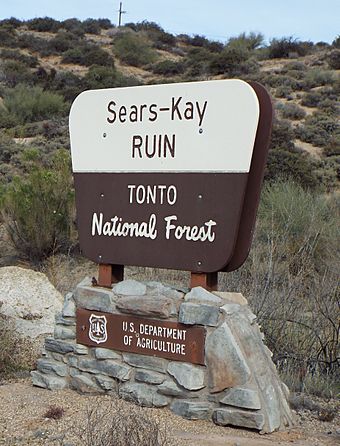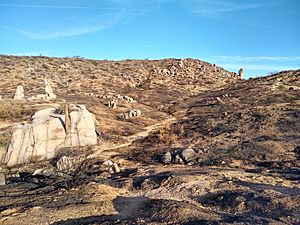Sears-Kay Ruin facts for kids
Quick facts for kids |
|
|
Sears-Kay Ruin
|
|

Marker at the entrance of the Sears-Kay Ruin
|
|
| Location | North Sears Kay Ruins Road, Tonto National Forest, Carefree, Arizona |
|---|---|
| Built | c. 1050 AD |
| NRHP reference No. | 95001310 |
| Added to NRHP | November 24, 1995 |
The Sears-Kay Ruin is an ancient fort built by the Hohokam people long ago. You can find these ruins in the Tonto National Forest, near Carefree, Arizona. It became a recognized historic place on November 24, 1995, listed in the National Register of Historic Places.
Discovering the Sears-Kay Ruin
Long ago, the desert hills around Carefree, Arizona, were home to the Hohokam people. The Hohokam might be the ancestors of today's Akimel O'odham and Tohono O'odham peoples.
The Hohokam built villages and strong forts to protect themselves. The Sears-Kay Ruin is one of these ancient forts. It sits high on a desert hill in the Tonto National Forest. This fort was built around the year 1050 AD. The Hohokam left the area around 1200 AD, and no one knows why they left. Later, the Tonto Apache tribe lived on this land.
In 1867, soldiers from Fort McDowell found the fort while on patrol. They were part of the 5th Cavalry Regiment. The fort was named Sears-Kay Ruin because it was on land that later became the Sears-Kay Ranch. J.M. Sears started this ranch in 1887.
The fort had about 40 rooms and could hold around 100 people. One special room is called the "Mystery Room." It's the only room with rounded corners instead of square ones. Because of this, archaeologists think it might have been built even earlier than the rest of the fort.
Exploring the Ancient Fort
You can hike on the hill where the fort is located. At the bottom of the hill, there is a sign that says: "Walk in the Path of Ancient Hohokam at Sears-Kay Ruin." This sign tells you about the path the Hohokam people used. Along the trail, other signs describe different parts of the ruins.
The entire area, including any old items found there, is protected. This protection comes from the Antiquities Act of 1906. This law was passed by the United States Congress and signed by President Theodore Roosevelt in 1906. It makes it illegal to take any artifacts from the site.
The law says that if anyone takes, digs up, damages, or destroys any old ruins or objects on government land without permission, they can be fined or even go to jail.
In September 2020, a wildfire burned much of the plants and trees around the site. This made the area less appealing for hiking for a while.
Images for kids












